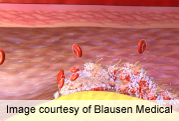
MONDAY, March 26 (HealthDay News) — Injecting a clot-busting drug directly into a blood clot caused by a certain kind of heart attack seems to save more heart muscle than extracting the clot does, a new study shows.
“In the patients who got the antiplatelet agent right in the blood clot, there was a significant reduction in the size of the heart attack,” said Dr. Gregg Stone, a professor of medicine at Columbia University Medical Center, in New York City.
He led the study, which was presented Sunday at the American College of Cardiology annual meeting in Chicago and published simultaneously in the Journal of the American Medical Association.
The researchers looked at 452 patients from 37 sites and six countries who had a heart attack known as a STEMI. Stone called this a “garden-variety” heart attack.
The patients in the study all had large STEMI heart attacks, and all arrived for medical care within four hours of the attack — which is not typically the case for many heart attack patients, experts said.
The established treatment for this type of heart attack is to perform a balloon angioplasty or to place a stent to open up the blocked or narrowed coronary arteries. However, recovery after these procedures is often not ideal, because small blood clots can occur.
To counteract this problem, doctors can use a drug-delivery catheter to inject a large dose of clot-buster drug into the clot. Or, they can use a different kind of catheter to extract the clot.
However, doctors have not known which method is better, Stone said.
His team randomly assigned 452 patients to one of four groups. One group got the clot extracted and a dose of clot buster known as abciximab (ReoPro). Another group got the clot extracted but did not receive the clot buster. A third group got the clot buster alone without extraction of the clot. A fourth group got neither the clot buster nor the clot extracted.
A month later, the researchers took MRIs of the patients. They wanted to see what effect each treatment had on the size of the heart attack. They evaluated that by taking into account the size of the infarct and total heart mass.
The clot buster reduced the damage of the heart attack. “In the patients who got the antiplatelet agent right in the blood clot, there was a significant reduction in the size of the heart attack,” he said. The reduction, he said, was about 15 percent.
“The bottom line is, the aspiration catheter [which extracts the clot], which is widely used, doesn’t seem like it had any benefit,” Stone said. “It should not be used routinely.”
Atrium Medical, which makes the drug-delivery catheter, was the primary sponsor of the study. Stone serves as a consultant for Atrium. He also serves as a consultant for Medtronic, which makes the extraction catheter used, and for Eli Lilly, which distributes ReoPro, and Daiichi-Sankyo.
The cost of ReoPro is $774 a vial, said Tina Gaines, a Lilly spokeswoman. Most people need three vials, she said, for a total cost of $2,322.
“The primary risk is bleeding,” Stone said. He found no difference in bleeding with or without the catheter. However, a larger study is needed to assess that more accurately, he said.
Stone emphasized the study does not apply to all heart attack patients. “We only studied patients with very large heart attacks,” he said, and they only looked at those who got medical care early. Taking those two factors into account, he said the findings would probably apply to about 20 percent of all heart attack patients.
“We always knew it was a very good drug,” said Dr. Jeffrey Berger, director of cardiovascular thrombosis at the NYU Langone Medical Center, in New York City. He reviewed the findings but did not take part in the study.
He called it an important study, with some caveats. For example, the researchers only looked at the patients 30 days after the heart attack. “There is a trend toward improvement [with the clot-buster drug] but I think larger studies are needed to really understand whether or not this therapy can improve outcomes important to patients,” Berger said.
Chief among those, he said, is whether the clot buster substantially reduces the risk of another heart attack.
More information
To learn more about heart attack warning signs, visit the American Heart Association.

